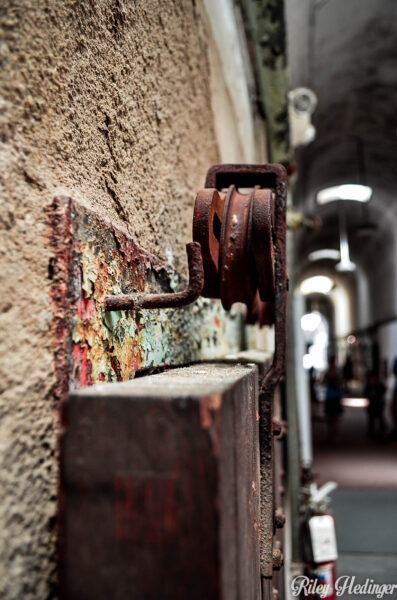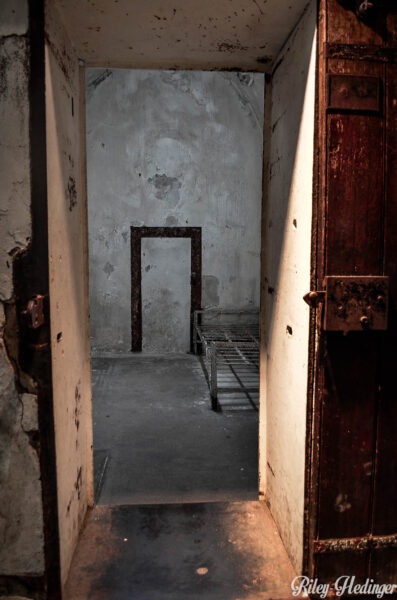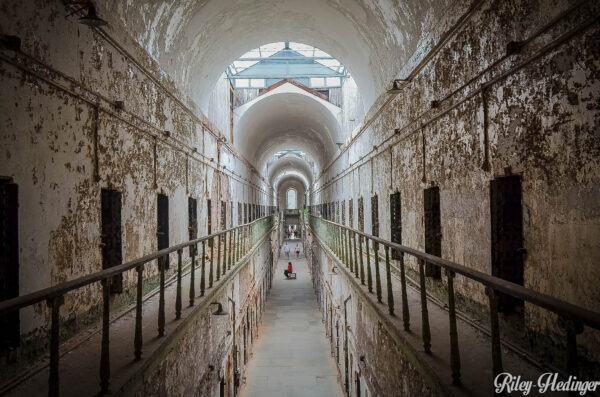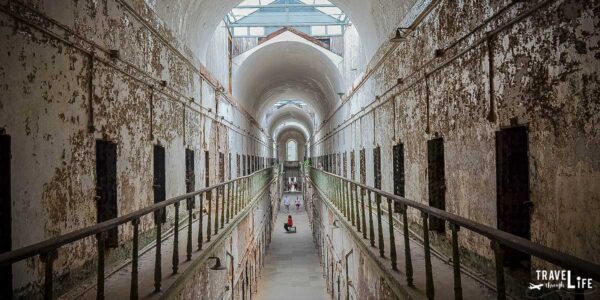Stepping into history can feel like an adventure, and even more so when stepping into a place so infamous. Add in the peak of summer in Philadelphia when air conditioning seems a distant memory and the only solace that comes from a hand-powered fan feverishly working to provide comfort. Walks down memory lane can also provide perspective into where we’re going as a society and that maybe, a U-turn might be necessary. A visit to the city allowed us a look at a most infamous attraction, Philadelphia’s Eastern State Penitentiary.
Eastern State Penitentiary
This post on Eastern State Penitentiary is a part of our series on Pennsylvania travel and USA travel. It was originally created on August 20, 2014. It has been maintained and updated (as of December 14, 2018) to reflect current viewpoints and travel trends. Background info found largely at Eastern State’s website.
Our Trip to Eastern State Penitentiary
Billed as the World’s first proper “penitentiary,” Eastern State’s creation led to a prison building movement that spanned the world’s far reaches. The institution’s early emphasis on total solitary confinement inspired global policy-makers while today’s crime historians might recognize, with Al Capone heading an All-Star list of criminals having spent time within its walls.
The “solitary system” eventually fell apart and things changed over time. Officials needed newer buildings and after a nearly 150-year run, Eastern State closed. The City of Philadelphia purchased the site and re-commissioned this historical relic into a tourist site.

The aforementioned Buscemi was in the city filming a movie when he first visited Eastern State. Fascinated, he wanted to take part and provided the voice behind the audio tour. Much of Eastern State’s history and countless prisoner stories are made available through this experience, though some of the building is impassable due to decay.
After finishing, an overwhelming display presents itself to visitors and shows just how many U.S. citizens experience detainment compared to the rest of the world. Honestly, it’s shocking. The U.S. holds “…the highest rate of incarceration in the world. Crime rates have gone up and down throughout these years. They are largely independent of the rate of incarceration.”

Taking a photo didn’t seem the right thing to do. It would feel like a celebration of this awful situation. Is this where we’ve come as a society? Lock them up in droves. Throw away the key. Is that how this country works? Moving on from Eastern State provided prison administrators with a hopeful look towards to the future but as it stands, the future has not been so bright for all the people who call bare white walls “home.”
Of course, it’s easy to say something needs to change and this situation is not acceptable. Perhaps instead of blindly following these stringent laws that are putting so many behind bars, maybe we should look at why so many people are going beyond the law in the first place.

But that’s the purpose of Eastern State. Bring it out into the light. A hokey and fun tour through a bit of history started a dialogue that needs to happen throughout. How can we change things to where these people are helping our society instead of being punished by it? It opened my eyes even further on the point that the situation ISN’T okay.
Our Thoughts and Yours, Too!
Eastern State is a relic in time that needs to be seen, just like anywhere else that is talking about a problem as huge as America’s “Prison” populations. Philadelphia’s Eastern State Penitentiary is more than a museum. It changed the prison system for 150 years. What’s to be learned from it?
What do you think we can learn from Eastern State?
Getting to Eastern State Penitentiary
Courtesy of the Eastern State Official Website
By Public Transportation (How we got there)
You can get there by taking the 48, 43, 33, 32, or 7 SEPTA buses.
#7, #32, #48 Buses
- Get off at 22nd and Fairmount Avenue.
- Walk east one block and you’ll see the entrance to Eastern State Penitentiary on the left-hand side of Fairmount Avenue and in between 21st and 22nd Streets.
#33, #20 Buses
- Get off at 20th and Fairmount.
- Walk west one block and the entrance to Eastern State Penitentiary is on the right-hand side of Fairmount Avenue between 21st and 22nd Streets.
- From the 43 bus, get off at 21st and Spring Garden Streets and walk north.
- Fairmount Avenue is the next major street, parallel to Spring Garden Street.
By Car
Coming from the North or West?
- Follow Interstate 76 (the Schuylkill Expressway) and get off at Exit 344 (Old Exit 38), which is actually Interstate 676. It’s also known as the Vine Street Expressway.
- On I-676 take the first exit, “Benjamin Franklin Parkway/ 23 Street.”
- Take the first left that you see, onto 22nd Street.
- Pass the Philadelphia Museum of Art that you’ll see on the left and continue north for five blocks towards Fairmount Avenue.
Coming from the South or East?
- Take I-95 to Exit 22 (Old Exit 17) and follow Interstate 676 West (Vine Street Expressway).
- Get off at the “Art Museum/Benjamin Franklin Parkway” Exit.
- Once at the top of the ramp, take a right onto 22nd street.
- Pass the Philadelphia Museum of Art that you’ll see on the left and continue north for five blocks towards Fairmount Avenue.
Parking
There is some on-street parking surrounding the Penitentiary but busy days might mean no nearby available spaces. Some is metered and there are some spaces that have limits on parking time. Check before leaving and you shouldn’t have any problems. Public parking is available next door to Eastern State and costs will go from $3.00 to $10.00 depending on your time spent there.


Fantastic images there Duke, and a great story to accompany them. You’d think after all these years we would have learnt from past mistakes. Maybe we have, but it often feels like two steps forward, three steps back…
Thank you, Andrew. It’s an interesting place to walk through, even if it was miserably hot that day. Even better hearing Steve Buscemi tell the stories.
If you haven’t read “Law Man: My Story of Robbing Banks, Winning Supreme Court Cases, and Finding Redemption, ” by Shon Hopwood, I highly recommend oy. He spent 10 years behind bars for committing five robberies. He became a jailhouse lawyer and two of his appeals on behalf of inmates were accepted by the Supreme Court, an almost-unheard of event. Upon release he finished college, and graduated from law school in June. Just this month, he started a coveted clerkship with for Judge Janice Rogers Brown of the United States Court of Appeals for the District of Columbia Circuit. It’s an amazing story of redemption.Unfortunately, prisons are built for punishment and not for giving inmates the tools to live a productive life when they get out.
It’s ridiculous that we have the highest incarceration rate. That’s just not right. I am not a fan of prisons but I would like to tour Alcatraz one day.
Having just toured Alcatraz, and finding that whole existence to be fascinatingly grim, I found your post not only timely but poignant. It is a sad state that we live in a country with the highest incarceration rate. Part of me thinks that punishments should be stronger to deter people from doing something wrong in the first place. Another part thinks prevention is key and that goes hand in hand with education. It’s definitely an interesting topic. And I agree with Jeri and Valerie – your photos are absolutely stunning!
Wow! Lots to think about here. Your photos are gorgeous. The stats are disturbing indeed and should encourage reflection on who we are and why so many are led to a life of crime… I could not help but think that perhaps one of the reasons other countries have less populated jails is because they are so quick to execute those who transgress…
Such great photos and what an atmosphere to experience. I’ve only toured Alcatraz, but it was worth it. It’s definitely messed up how so many people in America get incarcerated, but then again, if you can afford a good lawyer, that’s not always the case.